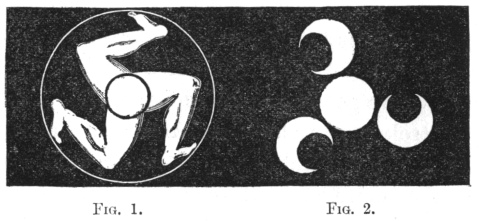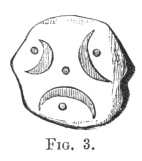
The Unicorn, a Mythological Investigation, by Robert Brown, [1881], at sacred-texts.com
THE next phase of the Unicorn is, I think, a novel one, and will solve a previously-felt difficulty. In the Pahlavi 1 work, the Bundahish or Bundahis, 2 is a circumstantial account of a wonderful animal called 'the Three-legged Ass,' which, according to M. Darmesteter, 3 is a personification of cloud, storm, etc.; but whilst this hypothesis can never be demonstrated, I think on a review of the evidence the contrary will clearly appear. The writer states;—
'Regarding the three-legged ass they say, that it stands amid the wide-formed ocean, and its feet are three, eyes six, mouths nine, ears two and HORN ONE, body white, food spiritual, and it is righteous.' 4
This puzzle to commentators now at once becomes luminous. The triform, triquetric Moon stands amid the wide Oversea of heaven, the 'mare magnum sine fine,' and 'its feet are three.' To what other personage or phenomenon would this apply? To attempt to explain every detail in the late and elaborated,
and possibly in part purely arbitrary, account would be very unsafe. Suffice it if the main outline comes out quite clearly. The Ass, a wise and sagacious animal, especially in Eastern idea, 1 has six eyes or two for each of the three phases; the Horse-Serpent-Dog-Moon has six eyes. There is some doubt about the word translated 'mouths;' it may mean 'testes,' and, if so, would connect the moon as usual with fertility and increase. The two ears may be the two ends of the horn, which is that of the lunar Unicorn. Its body is of course white—Leukotheê. From the archaic time of the Babylonian Moon-god Sin 'it is righteous,' nay, the leader of righteousness and of kosmic order; and as a righteous and heavenly being its food, if it have any, must be 'spiritual.'
The description continues;—
'And two of its six eyes are in the position of eyes,' i.e., in the full face or Serpent-moon; 'two on the top of the head' on the Dog-moon, the Half- or New-moon; 'and two in the position of the hump,' i.e., in the Unicorn-horse, the Crescent or Gibbous-moon. 'With the sharpness of these six eyes it overcomes and destroys;' 2 i.e., the dread lunar face and lunar eye which, as we have seen, drives away evil and scares wicked souls. The eye is the chief power of the Ass, as it is of the Gorgô. The whole extraordinary description is, on analysis, most palpably lunar.
'Of the nine mouths three are in the head, three
in the hump, and three in the inner part of the flanks.' 1 The mouths are distributed amongst the phases in the same manner as the eyes. The hump, so far as any actual animal supplies the imagery, will be that of the Indian ox. The increased number may express intensity, and the mouths be more or less Gorgonian.
'The one horn is as it were of gold and hollow. With that horn it will vanquish and dissipate all the vile corruption due to the efforts of noxious creatures.' 2 This is the pure bright unicorn's horn that drives away darkness and evil, cleanses streams and pools, and by which 'venym is defended.' 3
'When it stales in the ocean all the sea-water will become purified. . . . If, O three-legged ass! you were not created for the water, all the water in the sea would have perished.' 4 The sea-and-water-ruling moon.
'Tîstar seizes the water more completely from the ocean with the assistance of the three-legged ass.' 5 In Bundahis, vii. 2, we read;—
'Every single month is the owner of one constellation; the month Tîr is the fourth month of the year, Cancer 6 the fourth constellation from Aries, so it is the owner of Cancer, into which Tîstar sprang, and displayed the characteristics of a producer of
rain.' Tîstar, Tistrya or Tishtrya, is Sirius, 1 who, as the stellar protagonist, co-operates with the Moon in ruling water and regulating that humidity which is necessary to vitality.
'Tîstar was converted into three forms, the form of a man and the form of a horse and the form of a bull; thirty days and nights he was distinguished in brilliance; and in each form he produced rain ten days and nights; as the astrologers say that every constellation has three forms.' 2
In this very interesting passage we see the Triform Moon reduplicated in a triform Sirius, himself in his glorious light a second moon. His special period of brilliance is that of the lunar course, and like the Moon, he takes the forms of horse and bull. 3
When we get as late as the formulated systems of 'the astrologers,' each zodiacal constellation has three forms as divided into three decans, and it appears that the extra-zodiacal constellations were also regarded in some way as triform. These are the elaborations of previous simpler observation, and probably originally based upon, lunar triformity. Thus Tîstar 'the shining, majestic, the first ten nights unites himself with a body, with the body of a youth
of fifteen years, a shining one, with bright eyes. The second ten nights, Tîstar unites himself with a body, proceeding along the clear space, with the body of a bull with golden hoofs. 1 The third ten nights Tîstar unites himself with a body, with the body of a horse, a shining, beautiful one, with yellow ears, with a golden housing.' 2 These phases, however, do not really apply to Sirius but to Lunus, and hence their origin.
The three-legged lunar ass is found on coins and elsewhere under the familiar form of the Triquetra, 3 the origin of which appears thus;— 4
[paragraph continues] It is familiar on coins of Sicily as the national monetary type, a connexion however which is probably merely based upon the shape of the island—Trinacria or, as the Roman poets sometimes actually call it, Triquetra. But in the case of the Isle of Man no such reason can be admitted as explanatory. 5 Planché remarks;—
'The arms of Man are legs, or in less equivocal language, the ancient kingdom of Man was, and the island itself is still, represented in heraldry by three legs in armour, conjoined at the thighs. Our example of this heraldic curiosity 1 is particularly interesting, because the armour in which the legs are encased is the banded mail of the thirteenth century, and therefore presents us with the earliest appearance of the armorial coat of that Island and Sovereignty, after it had ceased to be Norwegian, A.D. 1264. The origin of the bearing has yet to be discovered.' 2 Behold it.
On coins of the ancient Greek city of Metabon (Metapontion-Metapontum) on the Tarentine Gulf, the three crescent legs appear in a variant phase thus;—The dots show that the three crescents
 |
Another coin of Metabon shows a bull's head, a type which may be lunar. 1
A triquetric ornament appears also at Troy and Mykênê. 2
62:1 'Using that term to denote the language of Persia during the Sassanian dynasty, A.D. 226-641' (R. B. Jr., R.Z., sec. v.).
62:2 'Kosmogony.'
62:3 O et A, 148 et seq.
62:4 Bundahis, cap. xix. sec. 1. Apud E. W. West, Pahlavi Texts.
63:1 Vide G.D.M. i. 65.
63:2 Bundahis, xix. 2.
64:1 Bundahis, sec. 3.
64:2 Ibid. secs. 6, 7.
64:3 Vide sec. I.
64:4 Bundahis, xix. 10.
64:5 Ibid. sec. 11.
64:6 Kalakang-Karkinos. In another Monograph (to appear in the Archaeologia) I have considered the origin of the Signs of the Zodiac, and their antezodiacal character.
65:1 Le génie de l’étoile Sirius' (Lenormant, Les Origines, 31). Cf. Plutarch: Ὡρομάζης τὸν οὐρανὸν ἄτροις ἐκόσμησεν· ἕνα δ᾽ ἀστέρα πρὸ πάντων οἷον φύλακα καὶ προόπτην ἐγκατέωτησε—τὸν Σείριον (Peri Is. xlvii. It is now usual to deny that Plutarch wrote this Tractate; but I see no sufficient reason for the scepticism).
65:2 Bundahis, vii. 4.
65:3 The bovine moon is, of course, not the subject of this Monograph.
66:1 Cf. the golden horn of the three-legged ass: the ancient Egyptians called silver 'white-gold.'
66:2 Khordah-Avesta, xxiv. 6, ap. Spiegel and Bleeck.
66:3 Vide sec. III. No. XXII.
66:4 Vide G.D.M. i. 408.
66:5 The Rev. Is. Taylor observes, 'Mona and the Isle of Man are p. 67 perhaps from the Welsh mon, separate' (Words and Places, 230, note 2). 'Separate' is but a feeble name to give to an island, considering also the wonderful suitability of nearly all truly archaic names. Far more probably is Man the Moon Island. The Triquetra seems to make this view almost an absolute certainty.
67:1 Vide Arms of Man tem. Edward I. Mis. Cur. Coll. of Arms. There is not the slightest evidence that the device was originally a Norman importation, or that it is really connected with any local features.
67:2 The Pursuivant of Arms, 143-4.
68:1 Astartê appears at times on coins as cow-headed or bull-headed, in accordance with the statement that 'she placed the head of a bull on her own head in token of sovereignty' (Sanch. i. 7). Pausanias (VI. xxiv. 5) mentions a statue of the Moon which had horns on its head, and Taurokerôs is an Orphik epithet of Selênê. So Porphyry states that the priestesses of Demeter 'called the moon, who presides over generation, a bull,' and adds, 'and Taurus is the exaltation of the Moon' (Peri tou en Odysseia tôn Nymphôn antrou, viii.). According to Olympiodoros (MS. Comment. on the Gorgias), 'the ancient theologists' said that 'the Moon is drawn by two bulls; by two, on account of her increase and diminution; by bulls, because as these till the ground [Not much tillage is done by bulls], so the Moon governs all those parts which surround the earth.'
68:2 Vide Schliemann, Mycenae, figs. 382, 428, 501, 511, etc.